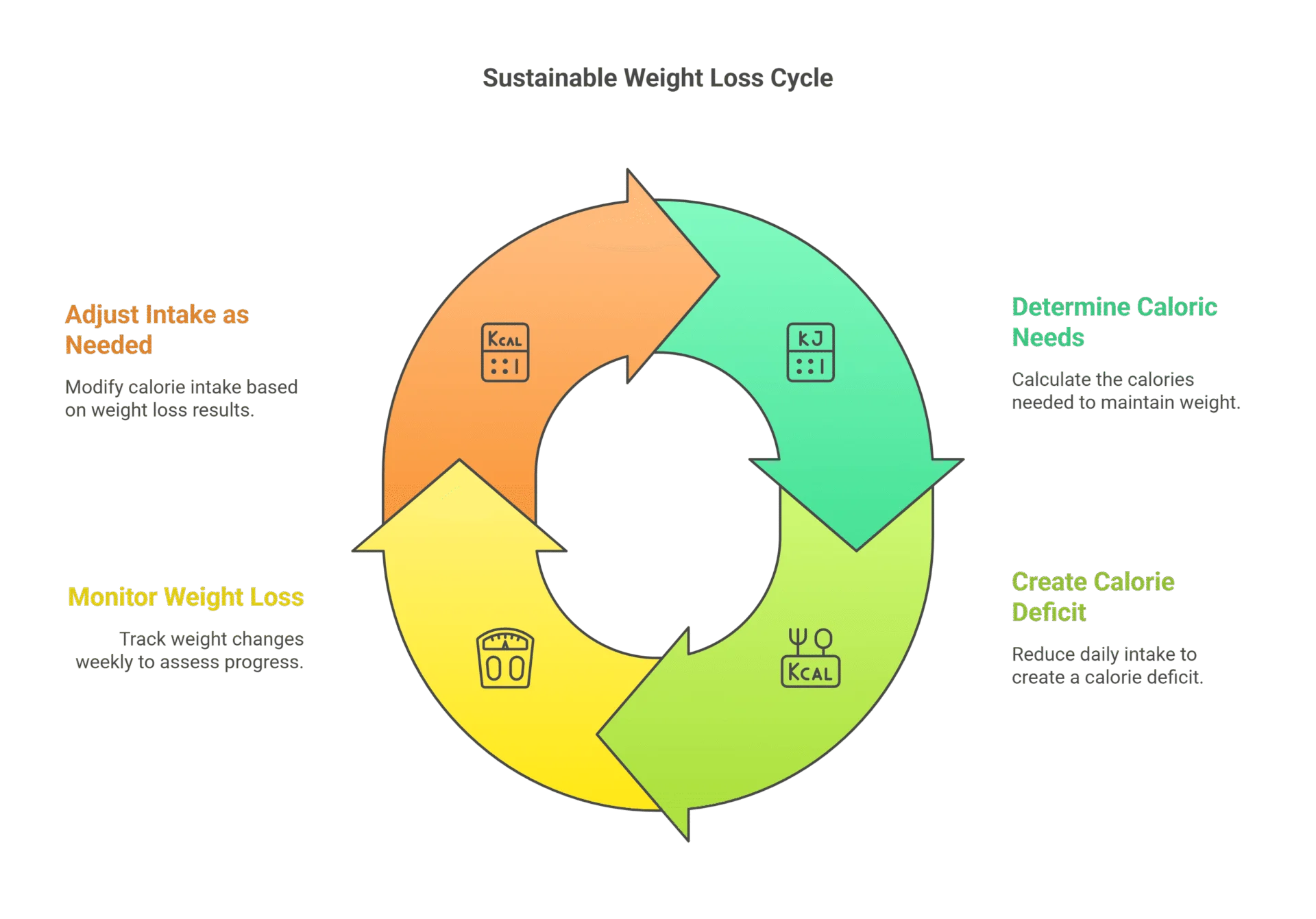Categories:
Ever thought about how much weight can you lose in a month? This is a common question for those starting a weight loss journey. Losing weight quickly is possible, but it’s more important to do it safely and for the long term. In this guide, we’ll look at how to lose weight effectively, aiming for a 10-pound loss in a month.
Weight loss is complex, influenced by diet, exercise, sleep, and stress. Knowing these factors is key for anyone wanting to lose weight, whether it’s 10 pounds or more. We’ll explore realistic weight loss goals and share tips to help you reach them.

Losing 10 pounds in a month is doable for some, but not everyone. Dr. Michael Glickman says losing 10 pounds in two to three months is more realistic. This matches the safe weight loss rate of 1-2 pounds per week.
In this article, we’ll cover weight loss basics like calorie deficits and exercise. We’ll also talk about nutrition, sleep, and managing stress. Whether you’re new to weight loss or looking to improve, this guide offers valuable insights to support your journey.
🔥 Shed Pounds Fast! Discover the Best Weight Loss Supplements Today!
Table of Contents
Key Takeaways
- Losing 10 pounds in a month is possible but may not be safe for everyone
- A safe weight loss rate is typically 1-2 pounds per week
- Creating a calorie deficit is essential for weight loss
- Exercise, like HIIT and strength training, can boost weight loss efforts
- Proper nutrition, sleep, and stress management play critical roles in weight loss
- Tracking meals and portion control can significantly impact weight loss success
- Sustainable lifestyle changes are key to long-term weight management
Understanding Safe and Sustainable Weight Loss
Losing weight isn’t just about quick results. It’s about making a plan that lets you lose 10 pounds or more in a healthy way. I’ll explain the science behind weight loss to help you understand how much you can lose in a month.
The Science Behind Weight Loss
Weight loss happens when you burn more calories than you eat. To lose 1 to 2 pounds a week, you need to burn 3,500 to 7,000 calories more. This means losing 4 to 8 pounds in a month. Some people might lose up to 10 pounds with a strict plan.
Water Weight vs. Fat Loss
When you start losing weight, you might see a quick drop on the scale. This is often water weight, not fat loss. True fat loss takes time and consistency. Aim to lose 1 to 2 pounds per week for lasting results.
Metabolic Changes During Weight Loss
As you lose weight, your metabolism might slow down. This is why diet and exercise are key. A 150-pound person can burn:
- 229 calories running for 20 minutes at 6 MPH
- 179 calories on the elliptical for 30 minutes
- 357 calories kickboxing for 30 minutes
Remember, slow and steady wins the race. Losing weight gradually, about 1 to 2 pounds per week, is more likely to lead to long-term success. Set realistic goals and focus on creating healthy habits to lose pounds in a month safely and sustainably.
⚡ Burn Fat Quickly! Get the Best Dietary Supplements for Weight Loss!
What Is a Realistic Amount of Weight to Lose in 30 Days
Starting a weight loss journey is exciting. But, it’s key to set realistic goals. I’ll guide you on what’s healthy and achievable in losing pounds per week. We’ll look at setting goals you can reach and keeping a healthy weight for good.
Setting Realistic Weight Loss Goals
A safe goal is to lose 1 to 2 pounds a week. That’s 4 to 8 pounds in a month. It might seem small, but slow and steady is best. Losing 5% of your body weight can greatly improve your health.
Factors Affecting Monthly Weight Loss
Many things can change how much weight you lose in 30 days:
- Starting weight
- Diet quality
- Exercise routine
- Sleep patterns
- Stress levels

Safe Weight Loss Guidelines
To lose weight safely, aim for a calorie deficit. Try to burn 500 to 750 calories more than you eat each day. This method helps keep the weight off for good.
| Activity | Frequency | Benefits |
|---|---|---|
| Aerobic Exercise | 30 minutes, most days | Improves cardiovascular health, burns calories |
| Strength Training | At least twice weekly | Builds muscle, boosts metabolism |
| Mindful Eating | Every meal | Helps control portions, prevents overeating |
Your weight loss journey is unique. Focus on building healthy habits, not quick results. This way, you’ll reach and keep a healthy weight for a long time.
🏋️♀️ Boost Your Results – Top-Rated Supplements to Help You Lose Weight!
The Role of Caloric Deficit in Weight Loss
Losing weight is all about creating a caloric deficit. This means you burn more calories than you eat. I’ll show you how to figure out your calorie needs, make a sustainable deficit, and track your food intake.
Understanding Your Daily Calorie Needs
Your daily calorie needs depend on your age, gender, and how active you are. Adult men usually need 2,000 to 3,000 calories. Women need 1,600 to 2,400 calories. These numbers change based on your lifestyle:
| Activity Level | Male Calorie Needs | Female Calorie Needs |
|---|---|---|
| Sedentary | 2,000 – 2,600 | 1,600 – 2,000 |
| Moderately Active | 2,200 – 2,800 | 1,800 – 2,200 |
| Active | 2,400 – 3,000 | 2,000 – 2,400 |
Creating a Sustainable Calorie Deficit
To lose weight safely, aim for a 500-calorie daily deficit. This can help you lose 1 to 2 pounds a week. If you weigh 180 pounds and need 2,000 calories to stay the same, eating 1,500 calories a day can help you reach your goal.

Tracking Calories Effectively
Use apps on your phone to track what you eat and exercise. Diet changes usually lead to a bigger calorie deficit than exercise. Avoid sugary drinks and choose complex carbs to stay full longer. Regular exercise, like 150 minutes of moderate activity and two strength training sessions a week, supports your weight loss and helps keep your new weight.
🚀 Transform Your Body! Try These Game-Changing Weight Loss Supplements!
Exercise Strategies for Maximum Weight Loss
Exercise is key to losing weight. I’ll share tips to help you lose weight and keep it off. By doing cardio and strength training, you burn calories, build muscle, and boost your metabolism.

Cardio exercises burn calories and help you lose weight. A 140-pound person burns about 7.6 calories per minute walking. Jogging increases that to 10.8 calories. Aim for 150-300 minutes of moderate aerobic activity each week to lose a lot of weight.
Strength training is also vital for losing weight. It helps keep muscle mass while you’re losing weight. A study showed that 11 minutes of strength training three times a week can increase your metabolic rate by 7.4%. This means you burn an extra 125 calories daily.
| Exercise Type | Calories Burned/Hour (160 lb person) | Benefits |
|---|---|---|
| Low-impact aerobics | 365 | Improves cardiovascular health, burns calories |
| Swimming | 423 | Full-body workout, reduces body fat |
| Running (5 mph) | 606 | High calorie burn, improves endurance |
| Strength training | Varies | Builds muscle, increases metabolism |
Consistency is important. Try to exercise regularly and mix up your workouts to avoid getting stuck. This way, you’ll lose weight well and keep it off for a long time.
🕒 No Time to Waste – Start Losing Weight with the Best Supplements Today!
Nutrition Guidelines for Losing 10 Pounds
Losing weight safely and effectively requires a balanced diet and exercise. As a dietitian, I recommend losing 1-2 pounds a week. This can be achieved through smart food choices and regular physical activity. Let’s explore some nutrition guidelines to help you shed those 10 pounds.
Anti-inflammatory Food Choices
Eating anti-inflammatory foods can support weight loss and overall health. I suggest incorporating plenty of colorful fruits, vegetables, whole grains, and lean proteins into your meals. These foods are nutrient-dense and can help you feel full while consuming fewer calories.

Protein Requirements
Adequate protein intake is key when trying to lose weight. It helps preserve muscle mass during calorie restriction and keeps you feeling satisfied. Aim for about 0.8-1 gram of protein per pound of body weight daily. Good sources include lean meats, fish, eggs, and plant-based options like beans and lentils.
Meal Timing and Portions
Timing your meals and controlling portions can make a big difference in your weight loss journey. I recommend eating smaller, balanced meals every 3-4 hours to keep your metabolism active. Use smaller plates to help control portion sizes, and try to finish eating a few hours before bedtime.
| Meal | Timing | Portion Size |
|---|---|---|
| Breakfast | Within 1 hour of waking | 1 cup of whole grains, 1 serving of protein, 1 serving of fruit |
| Lunch | 4-5 hours after breakfast | Palm-sized protein, 1 cup vegetables, 1/2 cup complex carbs |
| Dinner | 4-5 hours after lunch | Palm-sized protein, 2 cups vegetables, 1/2 cup complex carbs |
Remember, successful weight loss combines proper nutrition with regular strength training and cardio. By following these guidelines and maintaining a calorie deficit, you can work towards losing those 10 pounds safely and sustainably.
🍏 Natural Fat Burners That Actually Work – See the Best Picks Now!
The Impact of Sleep and Stress on Weight Loss

Sleep and stress are key to losing weight. As a registered dietitian, I’ve seen how bad sleep can ruin diet plans. More than a third of Americans don’t sleep enough, which hurts how our bodies work.
Not sleeping well means your body burns fewer calories. A study showed that just four days of bad sleep can make your body less good at using insulin. This changes how you process fats. Also, when tired, people often eat more carbs and fats.
Stress can also mess up your weight loss plans. High stress levels can make you gain or lose weight unexpectedly. Some might eat less, while others might eat more because of stress. Stress can also make it hard to sleep, starting a bad cycle.
To help with weight loss, try to sleep 7-9 hours each night. Stay away from caffeine after 2 p.m. to sleep better. For stress, exercise regularly and eat more whole grains and proteins. These steps can help your body burn calories better and support healthy weight loss.
| Sleep Duration | Impact on Weight Loss |
|---|---|
| Less than 6 hours | 15% reduction in metabolism during sleep |
| 7-9 hours | Optimal for weight management |
| More than 9 hours | May lead to oversleeping, affecting metabolism |
🔥 Say Goodbye to Belly Fat – Try These Top Weight Loss Supplements!
Building Healthy Habits for Long-term Success
To lose weight safely and keep it off, building healthy habits is key. Let’s explore how lifestyle changes, behavioral shifts, and support systems can help you succeed in the long run.
Lifestyle Modifications
To safely lose weight in a month, focus on making sustainable changes. Aim for 150 minutes of physical activity each week. Break it down to 30 minutes a day, 5 days a week. Include strength training twice a week.
Remember, it’s not about losing weight quickly. It’s about making steady progress.

Behavioral Changes
Small rewards can boost your motivation. A study found gym members were 16% more likely to exercise with minor incentives. Apply the 80-20 rule: eat healthy 80% of the time, and allow treats for the remaining 20%.
This balance helps you lose 1 to 2 pounds weekly without feeling deprived.
Support Systems
Tracking is key to losing weight effectively. Keep a journal to identify triggers and maintain accountability. Set SMART goals – you’re more likely to stick with your plan.
Remember, it may take 6 months to lose 5-10% of your body weight. But that’s healthy weight loss that lasts.
- Aim for 100 grams of protein daily
- Include 30 grams of fiber in your diet
- Eat slowly – it takes 15 minutes to feel full
- Stay consistent with your calorie deficit 4 out of 7 days a week
By focusing on these habits, you’re setting yourself up for sustainable, healthy weight loss. It’s not just about the numbers on the scale.
🎯 Hit Your Goals Faster with the #1 Weight Loss Supplements!
Common Weight Loss Mistakes to Avoid

Many people make mistakes that slow their weight loss progress. How long it takes to lose weight varies based on your starting weight and approach. Let’s explore some common mistakes to avoid for lasting weight loss.
Crash dieting is a big mistake. You might want to lose weight fast, but very low-calorie diets can harm your muscles and slow your metabolism. Aim for a moderate calorie deficit of 400-500 calories daily. This safe and sustainable approach helps you lose 1-2 pounds per week.
Another error is relying only on exercise. A study of over 4,700 people found that combining aerobic exercise with weight-lifting is best for fat loss. But, don’t overestimate how many calories you burn. Many people think they’ve burned more than they actually have.
- Avoid processed “low-fat” foods – they often contain hidden sugars
- Don’t skip meals – eating 2-3 times daily can help control appetite
- Be wary of liquid calories from juices and sodas
- Get enough sleep – lack of rest can spike cortisol and slow fat burning
Remember, sustainable weight loss isn’t about being perfect. Consistency is key. Aim to hit your nutrition and exercise goals 80-90% of the time. This balanced approach will help you avoid common mistakes and achieve lasting results.
Conclusion
I’ve looked into how much weight you can lose in a month and given tips to lose 10 pounds safely. Losing weight is not just about quick results. It’s about building lasting habits. Losing 1-2 pounds a week is a better goal for keeping the weight off.
Your weight loss path is unique, shaped by your age, starting weight, and lifestyle. Some might lose more weight at first, depending on how much they need to lose. But don’t worry if it takes time. Staying consistent is the key to reaching your goals.
The real goal is to keep the weight off for good. A balanced diet, regular exercise, enough sleep, and managing stress are all important. Think of your weight loss journey as a long race, not a sprint. Stay focused, be patient, and celebrate every small win.
For more help and support, try the Healthi app. It has tools to track your progress and keep you motivated on your weight loss journey.
🌟 Rated & Reviewed – The Best Weight Loss Supplements You Need!
FAQ
For “How Much Weight Can You Lose in a Month? Tips to Lose 10 Pounds”
Q: How much weight is it realistic to lose in a month?
A: A healthy weight loss rate is typically 1-2 pounds per week, which translates to about 4-8 pounds per month. However, this can vary depending on your starting weight, diet, and exercise routine. It’s possible to lose 10 pounds in a month, but it’s important to focus on sustainable, long-term changes rather than rapid weight loss.
Q: What’s the best diet to take to lose weight quickly?
A: While there’s no one-size-fits-all approach, a balanced diet rich in whole foods, lean proteins, fruits, vegetables, and whole grains is generally recommended. Focus on creating a calorie deficit by reducing portion sizes and choosing nutrient-dense foods. Remember, the best diet is one you can stick to long-term, as quick weight loss often leads to regaining the weight.
- Packaging may vary – New look, with the same trusted quality
- Gold standard 100% whey blend – 24 gram blended protein consisting of whey protein isolate, whey protein concentrate, an…
- Over 5 grams of BCAAS – Help build lean and strong muscles with naturally occurring BCAAs
Q: How does strength training impact weight loss?
A: Strength training is an excellent way to lose weight and improve body composition. It helps build lean muscle mass, which increases your metabolism and helps you burn more calories even at rest. Incorporate strength training exercises 2-3 days a week alongside cardio for optimal results.
Q: How long does it take to see noticeable weight loss results?
A: Many people start to see noticeable changes within the first month of consistent effort. However, everyone is different, and factors like your starting weight, diet, exercise routine, and genetics can influence how quickly you see results. Focus on non-scale victories too, such as increased energy and better-fitting clothes.
Q: Why is portion control important for weight loss?
A: Practicing portion control is one of the best ways to lose weight without drastically changing your diet. It helps you consume fewer calories while still enjoying your favorite foods. Use smaller plates, measure servings, and be mindful of your hunger cues to avoid overeating.
Q: How much water should I drink to support weight loss?
A: Drinking plenty of water is crucial for weight loss and overall health. Aim for at least 8 glasses (64 ounces) per day, or more if you’re active or in a hot climate. Water can help you feel full, boost metabolism, and support your body’s functions during weight loss.
- Stainless Steel Construction: Spill-proof shaker bottle made of BPA-free stainless steel for mixing supplements and smoo…
- Large 24-Ounce Capacity: Interior markings go to 20 ounces for plenty of room to mix supplements, meal replacements or w…
- Includes Wire Whisk: Features a 316 surgical-grade stainless steel wire whisk that mixes when the bottle is shaken for s…
Q: Is rapid weight loss safe or sustainable?
A: Rapid weight loss, while tempting, is often not healthy or sustainable. Losing weight too quickly can lead to muscle loss, nutrient deficiencies, and a higher likelihood of regaining the weight. The National Institute of Diabetes and Digestive and Kidney Diseases recommends a gradual, steady approach for long-term success.
Q: What are some tips for healthy weight loss in the first month?
A: For healthy weight loss in the first month, focus on eating a balanced diet, incorporating regular exercise (both cardio and strength training), getting enough sleep, managing stress, and staying hydrated. Set realistic goals, track your progress, and remember that sustainable weight loss takes time.
Q: How many calories should I eat to lose weight?
A: The number of calories you need depends on factors like your age, gender, current weight, activity level, and weight loss goals. As a general rule, creating a deficit of 500-750 calories per day can lead to 1-1.5 pounds of weight loss per week. Consult with a healthcare professional or registered dietitian to determine the right calorie intake for your specific needs.
Q: Can I lose weight without exercise?
A: While it’s possible to lose weight through diet alone, incorporating exercise into your routine can accelerate weight loss and improve overall health. Physical activity helps burn calories, build muscle, and boost metabolism. Aim for at least 150 minutes of moderate-intensity exercise or 75 minutes of vigorous-intensity exercise per week, along with strength training, for optimal results.
- 【Versatile Fitness Solution】: This multifunctional treadmill combines walking, under desk running, and vibration modes, …
- 【Powerful Yet Quiet Performance】: With a 2.5HP servo motor, this treadmill delivers speeds from 0.2 to 3.8 mph and suppo…
- 【Intuitive Fitness Tracking】: The LED display and Sperax Fitness app provide real-time monitoring of essential metrics l…
Related Articles:
- What is the Best Snack for Weight Loss? Healthy Snacks Under 100 Calories
- 10 Low-Calorie Snacks to Help You Stay Fit and Festive
- How Many Calories Should I Eat to Lose 2 Pounds a Week? Weight Loss Tips
- 10 Great Supplements for Weight Loss to Kickstart Your Fitness Journey
- 10 Must-Try Herbal Teas for Weight Loss Before Summer Hits
Our Partners: CSKDesignCrafts.com – DesignersReport.com – LifeCraftCentre.com
This post may contain affiliate links which means I may receive a commission for purchases made through links. There is no additional charge to you! Thank you for supporting my blog so I can continue creating free content each week!











